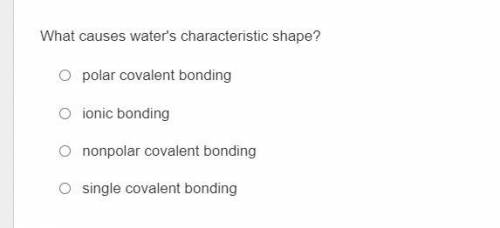
Physics, 13.04.2021 17:40 lizzyhearts
Ok this is the one i need help with but no
links bc i know its viruses


Answers: 2


Other questions on the subject: Physics

Physics, 22.06.2019 03:30, biancabell3
Acoyote chasing a rabbit is moving 8.00 m/s due east at one moment and 8.80 m/s due south 4.25 s later. let the x axis point due east and the y axis point due north. find the direction of the coyote's average acceleration during that time.
Answers: 1

Physics, 22.06.2019 06:30, bradleydb222
5submission this assignment is worth 20 points total. you are required to submit the following by next lab: 1. (3 points) determine the equation for the output angular velocity ω2 = θ˙ 2 as a function of θ1, ω1 = θ˙ 1 and α. you must show all your work to receive credit. 2. (2 points) use the result of problem#1 to plot ω2 over 0 ≤ θ1 ≤ 360deg with ω1 = 360deg/sec. do this for α = {10,30}deg. show the results on the same plot and properly label the axes, title, legend. for this you can use matlab or ms excel. 3. (3 points) determine the equation for the output angular acceleration ω˙ 2 and create a plot similar to the one in problem#2. 4. (10 points) submit plots of the results (ω2 and ω˙ 2) obtained from creo/mechanism and compare them to results of problem#2 and problem#3. note that you should do these comparisons for the two cases with α = {10,30}deg. 5. (2 points) provide a brief explanation of the results. did they match? what are the implications as misalignment angle increases?
Answers: 3

Physics, 22.06.2019 07:00, jeremiahphillip4396
The speed of sound in ice, water, and steam is shown. what best explains the speed of sound in different states of matter? sound travels fastest in ice because energy is easier to transfer when the molecules are close together. sound travels slowest in steam because the sound has to move around the gas molecules that are far apart. sound travels fastest in ice because the temperature of solids is always greater, so the heat transfers the sound energy. sound travels slowest in steam because the pressure is so great the sound cannot travel though the steam particles.
Answers: 1

Physics, 22.06.2019 16:10, Wemaybewrong
Amass weighing 24 pounds, attached to the end of a spring, stretches it 4 inches. initially, the mass is released from rest from a point 8 inches below the equilibrium position. find the equation of motion. (use g = 32 ft/s2 for the acceleration due to gravity.)
Answers: 1
You know the right answer?
Ok this is the one i need help with but no
links bc i know its viruses
...
links bc i know its viruses
...
Questions in other subjects:

Mathematics, 12.11.2020 01:00

Mathematics, 12.11.2020 01:00

Mathematics, 12.11.2020 01:00

Mathematics, 12.11.2020 01:00

Mathematics, 12.11.2020 01:00


Chemistry, 12.11.2020 01:00

Health, 12.11.2020 01:00




